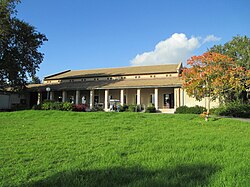Ginegar
| Ginegar | |
|---|---|
 |
|
| Coordinates: 32°39′50.03″N 35°15′29.87″E / 32.6638972°N 35.2582972°ECoordinates: 32°39′50.03″N 35°15′29.87″E / 32.6638972°N 35.2582972°E | |
| District | Northern |
| Council | Jezreel Valley |
| Affiliation | Kibbutz Movement |
| Founded | 1922 |
| Founded by | Polish and Russian immigrants |
| Population (2015) | 655 |
| Website | www.ginegar.net |
Ginegar (Hebrew: גִּנֵּיגָר), is a kibbutz in northern Israel not far from Nazareth. Located near Migdal HaEmek, it falls under the jurisdiction of Jezreel Valley Regional Council. In 2015 it had a population of 655.
In the late 19th century, towards the end of the Ottoman era, there was a small Arab village here called Junjar. In 1882, the Palestine Exploration Fund's Survey of Western Palestine (SWP) described Junjar as a small adobe village, at the foot of the hills, supplied by a well.
Gottlieb Schumacher, as part of surveying for the construction of the Jezreel Valley railway, noted in 1900 that Junjar had increased slightly (compared with the SWP-findings), and it then numbered 16 huts and had about 70 inhabitants.
In 1921, 4,000 dunums of land in Jinjar was sold to Zionist groups by the Sursock family, its absentee landlords in Lebanon. At the time, there were 25 families living there.
At the time of the 1922 census of Palestine Jenjar had a population of 175; 13 Jews, 118 Muslims and 44 Christian, where the Christians were 31 Orthodox and 13 Roman Catholics.
The kibbutz was established in 1922 in the Lower Galilee on the eve of Rosh Hashanah. The Kibbutz was named after the ancient well of Gingar, which can today still be found under the laundry. The kibbutz founders, working at moshavim in the area at the time, came in the second and third Aliyahs. They joined together in 1920 to establish Degania Gimel south of Degania Bet, at a site later used by kibbutz Beit Zera. From here they needed to move due to a lack of land, and so they arrived at Ginegar, which is believed to be a distortion of Nagnager, a village in the Galilee cited in the Talmud.
...
Wikipedia

